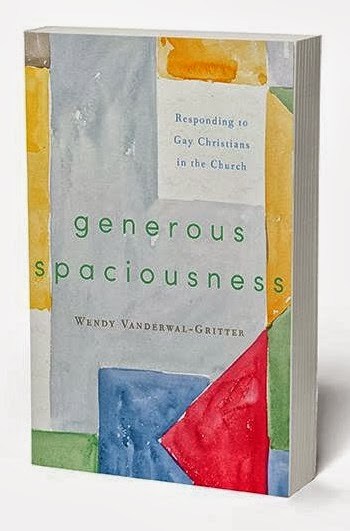 Wendy VanderWal-Gritter has spent more than 10 years leading New Directions Ministries, a Canadian group formerly under the umbrella of Exodus International. She and the ministry she leads have since moved out of an ex-gay paradigm. Generous Spaciousness: Responding to the Gay Christians in the Church (Brazos Press, 2014) is part memoir and part counsel on how to display love to gay-identifying people who want to explore Christian faith, whether as a return to the faith of their childhood or for the first time.
Wendy VanderWal-Gritter has spent more than 10 years leading New Directions Ministries, a Canadian group formerly under the umbrella of Exodus International. She and the ministry she leads have since moved out of an ex-gay paradigm. Generous Spaciousness: Responding to the Gay Christians in the Church (Brazos Press, 2014) is part memoir and part counsel on how to display love to gay-identifying people who want to explore Christian faith, whether as a return to the faith of their childhood or for the first time.
The book begins with a review of the common modes of approach to the issue among evangelicals, which was the author’s own approach at the outset. Over time, the one-sidedly doctrinaire and impersonal attitude became unsatisfying to her, and in the middle of the book she engages with the importance of people’s stories in their pursuit of Christlikeness, with the importance of integrating sexuality into oneself regardless of theological perspective, and with the diversity of theological perspectives held by equally convinced and sincere Christians. She passes on to consider how disputes and reforms on gay issues can be handled within congregations, and concludes with some very helpful chapters on pastoring people who may be struggling with—or who may have made it past a struggle with—a gay identity, on engaging the church as a gay Christian, and on intelligent and loving advocacy for gay people in Christian contexts.
The central theme of the book is the need for what she calls “generous spaciousness”—i.e., giving people (particularly gay people) an environment in which they can wrestle with questions about theology, Scripture, Christian history, and their own attractions, identities, and sense of self. Doing so without subjecting them to condemnation or a cold shoulder for asking the questions or for answering them in a way others disagree with or dislike is, she urges, indispensable.
Those who come to this book looking for a straightforward statement of the author’s moral views for or against homosexual relationships or gay marriage will be disappointed. Her focus lies elsewhere: namely, in creating a safe environment in the church for gay and questioning people to come to know both God and themselves under the guidance of the Holy Ghost, and leaving the results of that journey to God.
The book is generally solid, and its call for mutual respect and support is timely, particularly in a culture that is so polarized by gay issues. However, I think the author overrates the extent to which differing views of sexuality can coexist within a single congregation or denomination. If same-sex relationships are morally equivalent to opposite-sex ones, then objecting to them is cruel; if they are not, then approving of them is unfaithful. This need not affect our view of the intentions of those we disagree with, and people certainly need space (space they too frequently don’t get) to wrestle authentically with what they believe and why; but the divergence between the two views cannot be dismissed, and I’m skeptical that space for both conclusions can—or should—be maintained within a single body. I think, too, that she underestimates the degree to which people discovering a possible gay identity, especially young people, do crave clear and theologically grounded answers from their leaders, whether they finally assent to those answers or not. Even if they ultimately leave a church over this issue, I believe that they will want to know where they stand and why—as Edmund says in The Voyage of the Dawn Treader, “If there’s a wasp in the room I like to be able to see it.”
In total, though, I consider the book a good and helpful one for the way it situates the debate in its personal, real-world context. I’d recommend it to pastors and other ministers looking for an introduction to shepherding gay-identifying people who want to do so with manifest love, and to those who want to acquaint themselves with the atmosphere of the discussion of gay issues in North American churches.
Gabriel Blanchard lives in Baltimore, and is the author of the blog Mudblood Catholic. A convert to Catholicism, he writes about faith, gay issues, the arts, and politics, and subsists largely on sushi and coffee.


